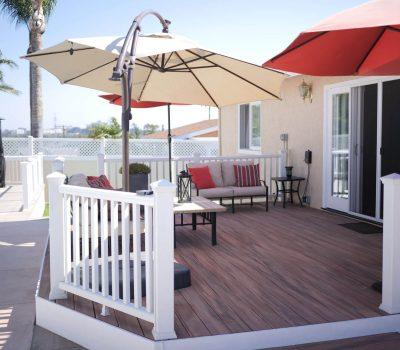It’s common for flooding and drainage issues after storms like Hurricane/Tropical Storm Hilary. With the rapid rate of rain at times, paired with San Diego’s canyon and river areas having a constant change of elevation, areas may flood regularly. Whether you have flooding in your home due to landscape or hardscaping issues, or have a leaking retaining wall, we’re here to help assess the damage and find long term solutions to drainage and flooding issues.
We offer free estimates and consultation on exterior remodeling services for your back, front, or side yard. We also offer roofing services, to fix those leaky roofs that often lead to significant interior damage.
Flooding can cause significant damage to a home and its surroundings, leading to expensive repairs and a reduction in property value. One of the most effective ways to prevent this problem is to appropriately design and maintain the landscaping and hardscaping around the property. When done right, these elements can work harmoniously to redirect water away from critical areas, ensuring the safety and longevity of the property.
How San Diego homeowners can harness the power of landscaping and hardscaping to combat flooding:
Understand Your Property’s Natural Flow: Begin by observing your property during a heavy rain. Notice where the water flows and pools. Your aim should be to guide this water away from your home and into appropriate drainage areas.
Grading: The angle at which your yard slopes is vital for flood prevention. The ground should always slope away from the home’s foundation. Ideally, for the first ten feet around your home, there should be at least a six-inch drop in elevation. If the grading is not correct, consider regrading or filling to create the right slope.
Soil Considerations: The type of soil in your yard plays a significant role in water absorption. Sandy soils drain faster than clayey soils. If your yard has compacted or clayey soil, consider amending it with compost or organic matter to improve its drainage capability.
Rain Gardens: Rain gardens are shallow, vegetated basins that collect and absorb runoff from rooftops, driveways, and other hard surfaces. Planted with water-loving plants, they can hold water and allow it to slowly infiltrate into the ground, reducing the risk of flooding. 5. Swales: These are shallow channels designed to redirect water away from the home and into safe areas, like storm drains or rain gardens. Swales can be grassy or filled with rocks, and they help in slowing down water flow and facilitating groundwater recharge.
Retaining Walls: In properties with significant sloping, retaining walls can be built to prevent erosion and manage runoff. These walls hold back soil and redirect water, ensuring it doesn’t flood sensitive areas.
Ground Covers and Deep-Rooted Plants: Planting ground covers like clover or ivy can help prevent soil erosion by holding the soil in place. Similarly, plants with deep roots, such as certain native grasses, can help absorb excess water and prevent surface runoff.
Permeable Paving: Traditional concrete or asphalt driveways and patios can exacerbate flooding since they don’t allow water to seep through. Consider permeable options like pavers, which have spaces for water to drain, or permeable asphalt and concrete. These allow water to pass through and get absorbed into the ground below.
Install Gutters and Rain Barrels: Position rain barrels at gutter and other downspout locations to collect runoff from rooftops. This not only prevents immediate flooding but also provides a reserve of water that can be used later for watering plants.
Clean and Maintain Gutters and Downspouts: Ensuring that gutters and downspouts are clear of debris is crucial. Blocked gutters can cause water to overflow and pool around the foundation. Ensure downspouts direct water at least 5-10 feet away from the home’s foundation.
Raised Beds and Planters: For areas close to the house, consider using raised beds for planting. These beds ensure that water doesn’t pool close to your home’s foundation and provides better drainage for plants.
Tree Planting and Root Barriers: Large trees can help absorb significant amounts of water. However, ensure they’re planted at safe distances from your home to avoid root interference with the foundation. Installing root barriers can also prevent potential foundation damage.
Install Drains: For patios, driveways, or other hardscaped areas, consider installing drains to capture and redirect water. French drains, for example, are trenches filled with gravel that redirect water away from the house.
Hardscape Borders: When creating paths or patios, ensure they have a slight edge or border. This can help contain water and direct it away from the house. Properly drained hardscaping is essential to a maintenance and flood free San Diego yard.
Regularly Inspect and Repair: Lastly, always keep an eye out for signs of wear and tear. Broken pavers, cracked concrete, or eroded areas can become problem spots for water pooling.






